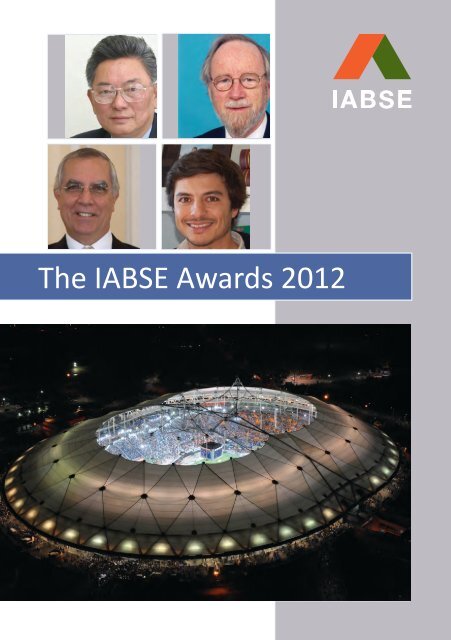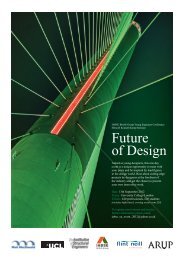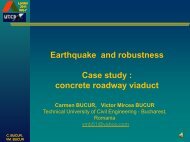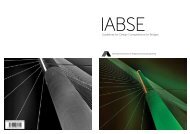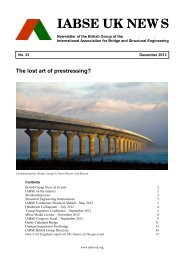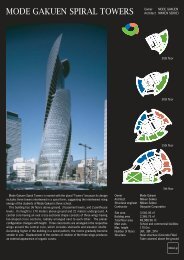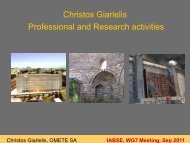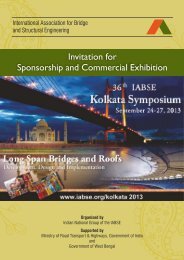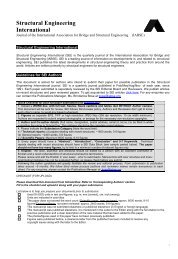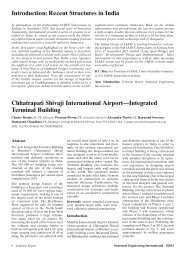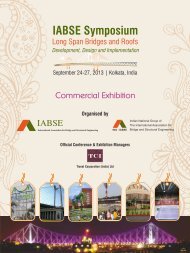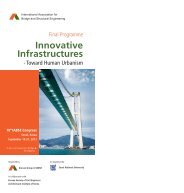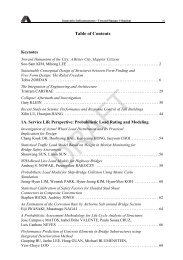The IABSE Awards 2012 - International Association for Bridge and ...
The IABSE Awards 2012 - International Association for Bridge and ...
The IABSE Awards 2012 - International Association for Bridge and ...
You also want an ePaper? Increase the reach of your titles
YUMPU automatically turns print PDFs into web optimized ePapers that Google loves.
<strong>IABSE</strong> Prize<strong>The</strong> <strong>IABSE</strong> Prize honours a Member early in his, or her career <strong>for</strong> an outst<strong>and</strong>ingachievement in the field of structural engineering, in Research, Design or Construction.<strong>The</strong> Prize is presented to Individual Members of <strong>IABSE</strong>, <strong>for</strong>ty years ofage or younger. <strong>IABSE</strong> has conferred the <strong>IABSE</strong> Prize <strong>2012</strong> to João Ramôa Correia,Portugal,“in recognition of his important research in GFRP structures, leading to significantachievements internationally awarded”.João Ramôa Correia, graduated in Civil Engineering fromIST – Technical University of Lisbon in 2001, being the bestCivil Engineering student of that year. Afterwards he receivedhis MSc in 2004 <strong>and</strong> did his PhD in 2008, always with thehighest qualifications. Since 2008 he is Assistant Professor atIST, teaching the areas of rehabilitation <strong>and</strong> new materials.During the development of his PhD, he also worked at‘École Polytechnique Fédérale de Lausanne (EPFL), Switzerl<strong>and</strong>.After completion of his PhD he has been involved inresearch in new materials, namely GFRP, with significantresults expressed in recent years by:João Ramôa Correia- 35 scientific journal papers, 55 conference papers, several prizes <strong>and</strong> honours;<strong>and</strong> two patents.At <strong>IABSE</strong> he was one of the founding members of Working Group 2: ‘FRP Structures’where he has an active participation, with work leading to the ‘Outst<strong>and</strong>ing YoungEngineer Contribution Award’ at the <strong>IABSE</strong> Weimar Symposium 2007. Besides hisresearch activities he has also been involved in several consulting projects, associatedwith 130 technical reports, dealing with bridge behaviour <strong>and</strong> testing <strong>and</strong>structures rehabilitation. He has developed innovative software (BIST) to estimatebridge safety under trucks overloaded, presently being used in major national motorways,<strong>for</strong> which he has received a national prize.João Correia, has already an impressive curriculum associated with research in newmaterials, with several practical engineering applications <strong>and</strong> with national <strong>and</strong> internationalprizes.4
Outst<strong>and</strong>ing Paper Award - Technical Report<strong>The</strong> Outst<strong>and</strong>ing Paper Award (OPA) is remitted each year to the author(s)of a paper published in the preceding year’s issues of the <strong>IABSE</strong> JournalStructural Engineering <strong>International</strong> (SEI), encouraging <strong>and</strong> rewarding contributionsof the highest quality. Starting with the 2011 Outst<strong>and</strong>ing PaperAward, it is presented in the categories ‘Technical Report’ <strong>and</strong> ‘Scientific Paper’.<strong>The</strong> OPA Committee, was chaired by Martina Schnellenbach-Held, Germany.<strong>IABSE</strong> presents the Outst<strong>and</strong>ing Paper Award in the category ‘Techincal Report’ toPeter. Ch. Mulqueen, New Zeal<strong>and</strong> <strong>for</strong> his paper:“Creating the Te Rewa Rewa <strong>Bridge</strong>, New Zeal<strong>and</strong>”published in Structural Engineering <strong>International</strong> (SEI) 4/2011 (Nov.)This paper dissects the thought processes of thebridge designer as an example to demonstrate howstructural bridge elements can be contextualised toa bridge setting. This is in order <strong>for</strong> the bridge to beseen as a symbol with deep meaning to its local community,more than a purely functional brid <strong>for</strong>m ofnature that can be readily associated with the site.Making connections <strong>and</strong> relationships between thestructural elements <strong>and</strong> the history associated withthe site is creative linkage at its best. While there isnothing truly original about the Te Rewa Rewa <strong>Bridge</strong>, Peter Ch. Mulqueenthe strong links between the structure <strong>and</strong> nature possibly break new ground i nbridge aesthetics. <strong>The</strong> end product is a perfectly functional bridge with no loadingor vibration issues, which despite its modest size, magically enchants as a sculptural<strong>for</strong>m in changing light. <strong>The</strong> Rewa Rewa <strong>Bridge</strong> bridge at the edge of the world inTaranaki, New Zeal<strong>and</strong>, has become a potent symbol <strong>for</strong> the community in whichit is located.Te Rewa Rewa <strong>Bridge</strong>, NZ5
was interrupted, the triangular steel truss perimeter compression ring had alreadybeen completed <strong>and</strong> placed atop the seating berm, <strong>and</strong> materials that had beenpurchased <strong>for</strong> the dome were stored, awaiting a resurgence of the Argentineeconomy. In 2009, with the notification that Argentina had been chosen to host the2011 Copa América, construction was resumed.Originality <strong>and</strong> Innovation: La Plata Stadium is the first polytetrafluoroethylene(PTFE, commonly known as ‘Teflon’) covered stadium in South America <strong>and</strong> thefirst designed to use a fabric with a 24 % translucency. Its design is based on theconcept developed by architect Roberto Ferreira, which employs a unique dogboneconfiguration to provide separate identities <strong>for</strong> the two football teams that residethere. In plan, the two intersecting circles have 85 m radii, but their centres are only48 m apart. An arch resists the structure’s outward thrust across its pinched-waistcentreline. <strong>The</strong> dome’s patented Twinstar design is the first anywhere to adaptthe tensegrity roof concept to a twin-peak contour. It <strong>for</strong>ms a figure-eight-shapedcentral opening by using tension to resist global distortion. To accommodate theunconventional geometry of the stadium, the main roof structure was <strong>for</strong>medusing tensioned steel cable hoops at three levels, along with vertical columns,diagonal cables, <strong>and</strong> ridge cables. It is defined as a ‘spatial network in a state ofself-stress’. <strong>The</strong> system works like a truss in which the bottom chord is interrupted<strong>and</strong> then follows the line ofhoop cables around to theopposite side of the arena.As a truly three-dimensionalsystem, it benefits from thetriangularisation of structuralelements, which improvesits load-carrying capability<strong>and</strong> permits unconventionalgeometry.Interior of the completed stadium (Photo: Birdair Inc.)Sustainability Considerations: La Plata’s dome is constructed of extremely durablefabric <strong>and</strong> steel. <strong>The</strong> PTFE-fibreglass membrane it is clad in allows sufficientsunlight to nourish the stadium’s natural grass playing field. <strong>The</strong> fabric is capable ofwithst<strong>and</strong>ing temperatures from -75°C to 232°C <strong>and</strong> is flame-resistant, waterproof,<strong>and</strong> impervious to ultraviolet rays. All steel elements were fabricated locally. <strong>The</strong>durability <strong>and</strong> relatively low cost of the fabric make it an extremely economicalconstruction material. <strong>The</strong> roof is open along the perimeter to allow air to circulatenaturally without <strong>for</strong>ced ventilation in the final configuration of the roof, which willbe closed.8
Outst<strong>and</strong>ing Stucture Award - FinalistBusan-Geoje Fixed Link,Busan, Korea..is a dual two-lane highway,named the Gr<strong>and</strong> GeogaRoad <strong>and</strong> connects GeojeIsl<strong>and</strong> with Gaduk Isl<strong>and</strong> inBusan, Korea. This link has atotal length of 8,2 km <strong>and</strong> comprisesthree major structures:Busan-Geoje Fixed Link.1. A three-pylon cable-stayed bridge (main spans 230 m) with approach viaductsbetween Geoje <strong>and</strong> Jeo Isl<strong>and</strong>2. A two-pylon cable-stayed bridge (main span of 475 m) with approachviaducts between Jeo <strong>and</strong> Jungjuk Isl<strong>and</strong>s3. An immersed tunnel between Jungjuk <strong>and</strong> Gaduk Isl<strong>and</strong>s (3,7 km long)<strong>The</strong> Link is located at open sea <strong>and</strong> exposed to extreme wind <strong>and</strong> wave conditionsoriginating from typhoons. <strong>The</strong>se conditions with wave heights up to 13 m <strong>and</strong> criticalwind speeds up to 80 m/s have governed the design. In addition, because of theproximity to major shipping facilities, the structure is also prone to extreme vesselcollision loads. Owing to the proximity of the naval base, requirement on the concessionaireto provide <strong>for</strong> security reasons a tunnel under the principal navigationchannel, rather than a bridge, was indispensable. <strong>The</strong> immersed tunnel consists of18 elements <strong>and</strong> each element is approximately 180 m long.<strong>The</strong> severe conditions together with a deepest immersed tunnel ever built (48 mwater depth) on a very soft foundation make this project unique <strong>and</strong> one of themost challenging. Several special methods were developed to overcome the difficultconditions. Accurate gravel bedding equipment, external positioning system,<strong>and</strong> air injection method were developed <strong>for</strong> sinking <strong>and</strong> connecting the elementsof the immersed tunnel. To minimise off-shore work, large pre-cast units were used<strong>for</strong> all the structures except pylons. After completion of construction (2010), theBusan-Geoje Fixed Link provides the south-eastern part of Korea with a much neededtransport link. It has also become a l<strong>and</strong>mark in the development of Koreancapability in major project construction, with a number of innovative solutions toovercome significant challenges <strong>and</strong> will set new st<strong>and</strong>ards <strong>for</strong> long <strong>and</strong> deep offshoreimmersed tunnels in the future.9
Outst<strong>and</strong>ing Stucture Award - FinalistXihoumen <strong>Bridge</strong>, Zhoushan, ChinaXihoumen <strong>Bridge</strong>, Zhoushan, China..is a daring twin-box girder suspension bridge with movable wind barriers <strong>and</strong>combines in a perfect way outst<strong>and</strong>ing innovative ideas in harmony with a span of1650 m, the structural safety <strong>for</strong> critical flutter speed of 78,7 m/s <strong>and</strong> the extensiblefunction of vehicle operation under 41 m/s basic wind velocity.Located in Zhoushan Isl<strong>and</strong>s of Zhejiang Province, China, <strong>and</strong> connecting Cezi <strong>and</strong>Jintang Isl<strong>and</strong>s, the Xihoumen <strong>Bridge</strong> is both a mega structure offshore as the longestseacrossing span among a series of five large road bridges along the ZhoushanIsl<strong>and</strong> <strong>and</strong> Mainl<strong>and</strong> Link Project, <strong>and</strong> a strategic component in China’s NationalExpressway Network.Designed <strong>and</strong> built to a dual two-lane expressway st<strong>and</strong>ard with a total length of2588 m <strong>and</strong> an effective deck width of 24.5 m, its main structure consists of atwo-span continuous steel-box suspension bridge 1650 m in main span length <strong>and</strong>640 × 49.5 m in horizontal <strong>and</strong> vertical navigation clearance.<strong>The</strong> bridge is situated in an archipelagic environment <strong>and</strong>, all year round, subjectto severe natural surroundings featuring an annual average occurrence of 2,6 typhoons<strong>and</strong> a design deck datum wind velocity of 55,1 m/s at the bridge operationstage, hence constituting a tough challenge to both designers <strong>and</strong> contractors alike.Planning <strong>and</strong> design <strong>for</strong> the bridge started in 2000 with engineering works commencedin 2005 <strong>and</strong> the bridge opened to traffic on December 29, 2009. Completionof the Xihoumen <strong>Bridge</strong> has successfully brought <strong>for</strong>th many benefits <strong>for</strong> themillions of Zhoushan isl<strong>and</strong>ers in terms of eliminating once <strong>for</strong> all their bitter experienceof ferry-dependant travels, facilitating their isl<strong>and</strong>–mainl<strong>and</strong> trips <strong>and</strong>, tocrown it all, promoting the local socio-economic growth, just to name a few.10
Honorary MembershipHonorary Membership is presented to an IndividualMember of <strong>IABSE</strong>, <strong>for</strong> exceptionally great services renderedto the <strong>Association</strong>. <strong>IABSE</strong> has presented HonoraryMembership to Gilson Marchesini, Brazil, at the PermanentCommittee meeting on September 18, <strong>2012</strong>,“in high appreciation of his outst<strong>and</strong>ing <strong>and</strong> dedicatedservices to the <strong>Association</strong>, in particular as Vice-Presidentof <strong>IABSE</strong> from 2001-2009”.Gilson MarchesiniGilson Marchesini, graduated as a Civil Engineer in 1968 from the National Schoolof Engineering, University of Brazil (now the Federal University of Rio de Janeiro).After his studies, in 1969, he joined the company Sobrenco Engenharia, directed<strong>and</strong> owned by Sergio Marques de Souza, who was Vice-President of <strong>IABSE</strong> Chairof Brazilian Goup <strong>and</strong> Honorary Member of <strong>IABSE</strong>. In 1975/76 Gilson Marchesiniworked two years in Algeria <strong>for</strong> Rabello Constructions, where he participated instructural design, projects <strong>and</strong> construction work, <strong>for</strong> which Oscar Niemeyer haddone the architecural design. After he returned to Brazil, in 1977, he becameDirector of SOBRENCO <strong>and</strong> is since 2004 stock owner of the company.Gilson Marchesini joined <strong>IABSE</strong> in 1980. Through his personal engagement,he contributed considerably to the success of the Annual Meetings <strong>and</strong> <strong>IABSE</strong>Symposium in Rio 1999, <strong>for</strong> which he served both as a Member of the Organising<strong>and</strong> the Scientific Committees. He was a Member of the Scientific Committee ofNew Delhi 2005 <strong>and</strong> a Vice-President of <strong>IABSE</strong> from 2001-2009. He was one ofthe first to support to the so called ‘<strong>IABSE</strong> Lecture Series on the Internet’ withthe recording of the lectures from a Brazil Workshop he had organised in 2001together with Jörg Schneider, Switzerl<strong>and</strong>. He consecutively joined the E-LearningBoard in 2007, of which he is a Member until today. He continues to support the<strong>Association</strong> as a Fellow (since 2001 ), as Member of the Advisory Board of theExecutive Committee, as Vice-Chair of the Brazilian Group of <strong>IABSE</strong>, Delegateto the Permanent Committee, <strong>and</strong> as a Member of the Advisory Board <strong>for</strong> the2013 <strong>IABSE</strong> Symposium Kolkata.11
Anton Tedesko Medal(<strong>IABSE</strong> Foundation <strong>for</strong> the Advancement of Structural Engineering)‘in recognition of his dedication to excellence in structuralengineering <strong>and</strong> his role as mentor <strong>for</strong> young engineers’.Professor Emeritus Paul Grundy, Australia, is awardedwith the Anton Tedesko Medal <strong>2012</strong> by the <strong>IABSE</strong> Foundation<strong>for</strong> the Advancement of Structural Engineering.<strong>The</strong> Award consists of a medal <strong>for</strong> the Laureate in recognitionof his contribution to the advancement of structuralengineering. He also receives a sum of CHF 25’000to be used to organise <strong>and</strong> finance a study leave abroad<strong>for</strong> a young engineer (Fellow) with prestigious engineeringfirms.Paul GrundyPaul Grundy gained his first degrees in Civil Engineering from the University ofMelbourne <strong>and</strong> his PhD in 1961 at the University of Cambridge, UK. After practicalexperience in consulting engineering he returned to academia to serve MonashUniversity from 1966 to 2000, where he first was Chair Professor of Structural Engineering(1994) in the Department of Civil Engineering <strong>and</strong> then Head of Department(1996-1998).His professional experience <strong>and</strong> inquiries from industry lead him to his now centralinterest, the lifetime per<strong>for</strong>mance of structures (bridges, buildings, ship <strong>and</strong> offshorestructures) in hostile environments. Extensive research in fatigue, incrementalcollapse, corrosion, estimation of fatigue loads <strong>and</strong> design loads <strong>for</strong> ultimatestrength from traffic weigh-in-motion data, <strong>and</strong> risk assessment has resulted inmany publications, <strong>and</strong> more significantly, useful advice to industry. After his retirement(2001) he continued consulting in relation to structural integrity of ageingbridges <strong>and</strong> infrastructure affected by fatigue <strong>and</strong> corrosion, <strong>and</strong> a changing loadregime. In particular he has provided continuing advice on West Gate <strong>Bridge</strong>, fromits collapse during construction in 1970 <strong>and</strong> through subsequent upgrades, <strong>and</strong> hehas provided advice on wrought iron heritage bridges. Paul Grundy became Chairof the Australian Group in 1999 <strong>and</strong> served as Chair of the Scientific Committee<strong>for</strong> the <strong>IABSE</strong> Symposium Melbourne 2002 <strong>and</strong> played a major role in making theevent a success.Following the Tsunami of December 26, 2004, Paul Grundy launched the ‘JointWorking Commission <strong>for</strong> Disaster Reduction on Coasts’ at the <strong>IABSE</strong> Conference12
New Delhi already in February 2005. Groundwork was laid at a Symposium on ‘DisasterReduction on Coasts’ hosted by Paul Grundy in November 2005 at MonashUniversity. <strong>The</strong> scope of work has exp<strong>and</strong>ed to address all disasters resulting fromnatural hazards, co-operating with UN ISDR <strong>and</strong> UNESCO. Besides his passion <strong>for</strong>Disaster Reduction, Paul Grundy has dedicated time, energy <strong>and</strong> passion to <strong>IABSE</strong>.Paul Grundy became a Member of the Order of Australia (AM) in recognition ofhis work in 2008. In 2010 he was awarded the John Connell Gold Medal by EngineersAustralia <strong>for</strong> his outst<strong>and</strong>ing achievements in structural engineering. In 2011he toured Australia as an Eminent Speaker <strong>for</strong> Engineers Australia, on the subject‘Disaster Risk Reduction – the Engineer’s Role’. An e-lecture on this topic is in thee-learning section of the <strong>IABSE</strong> website.Within <strong>IABSE</strong>, he has since 1999 contributed to numerous Committees: Chair AustralianNational Group (1999-2010), Outst<strong>and</strong>ing Structure Award Committee (OstrA)(2001-2009); Organising <strong>and</strong> Scientific Committee Melbourne 2002; SEI ExternalReviewer (until 2003); WC 7 Sustainable Engineering (2003-2007) Outst<strong>and</strong>ingPaper Award Committee 2006; Permanent Committee Delegate.West Gate <strong>Bridge</strong>, Melbourne, Australia13
<strong>IABSE</strong>worldwide since 1929<strong>IABSE</strong>c/o ETH ZurichHoenggerberg HIL E21.3CH - 8093 ZurichSwitzerl<strong>and</strong>Phone: +41-44-633 2647secretariat@iabse.orgwww.iabse.org


